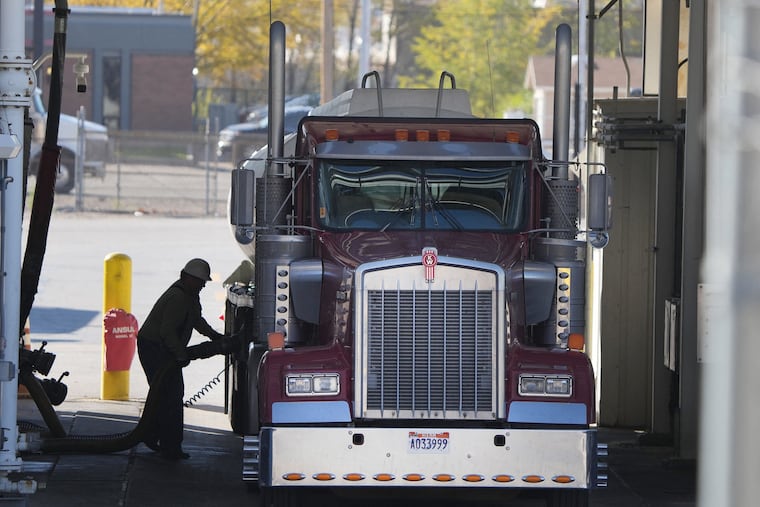How the Russian invasion of Ukraine could affect the U.S. economy
The Russian invasion, and the resulting higher oil prices, will likely make inflation worse. The Federal Reserve could be forced to raise interest rates more aggressively.

Russia’s invasion of Ukraine is taking a human toll and has put global democracies on the defensive, but under most scenarios it will have little fallout on our economy.
The principal link between the Russian invasion and the global economy is through oil, natural gas, and other commodity and industrial prices. This constitutes the bulk of what Russia and Ukraine export to the world.
Since it became clear that Russia was amassing troops on its border with Ukraine earlier this year, West Texas Intermediate oil prices have risen about $30 per barrel to more than $100 per barrel. Prices have risen even though global supplies have not been significantly disrupted by the Russian invasion, because the threat of an interruption remains. The increase in prices is a premium added for this risk.
» READ MORE: $4-a-gallon gasoline is coming, no matter what
If oil prices remain near $100 per barrel, then American consumers will pay almost $4 for a gallon of regular unleaded by this spring, up about 60 cents. This would ultimately add as much as half a percentage point to year-over-year consumer price inflation and reduce U.S. real GDP growth this year from an estimated 3.7% to 3.5%. This hurts, but it is a modest impact.
Of course, Russia’s invasion of Ukraine and the resulting higher oil prices, are especially bad timing as that will push already painfully high prices even higher. And gasoline prices play an outsize role in shaping our expectations about future inflation. Most of us purchase gas regularly and see the price each day as we go to and from work. Nothing influences people’s thinking about future inflation more than what they are currently paying at the pump.
If inflation expectations start to rise, then the Federal Reserve, fearful that the higher expectations become self-fulfilling, will have little choice but to raise interest rates more aggressively than it already is signaling it will do. Even before the Russian invasion, global investors had been anticipating a series of rate hikes this year. This will be difficult for the economy to adjust to, but any more rate hikes would meaningfully increase the odds that the economy will stumble. So far, inflation expectations are holding firm, but they bear close watching.
The wobbly stock market is another potential economic vulnerability that could be exposed by the Russian invasion. Stock prices are down about 10% from their all-time high at the start of the year, equal to a loss of about $5 trillion in market capitalization. This is largely due to investors adjusting to the prospects of the Fed tightening and higher interest rates and is consistent with a garden-variety correction. While the Russian invasion has caused big intraday swings in stock prices, they are still not far from where they were when all this began.
However, stocks remain significantly overvalued, and if events don’t stick precisely to script, which isn’t too hard to imagine, they are at risk of selling off. Another sustained 10% decline in stock prices would be consistent with a bear market, which would be the loss of real money for many households, causing them to turn more cautious in their spending. It would also signal that global investors are discounting an economic downturn straight ahead.
Russia and Ukraine’s outsize role in the global neon market could also surprisingly turn out to be a big problem, as neon is critical to the semiconductor-making process. If neon production and exports are disrupted, then chip production will be, too, with big implications for everything from consumer electronics to vehicles. This takes on added importance, given the ongoing supply-chain disruptions to the chip and chip-dependent industries caused by the pandemic.
There are many other possible darker scenarios on how Russia’s invasion of Ukraine will play out. Russia could curtail its exports of oil, natural gas, metals and industrial products. It is plausible under this scenario that oil prices spike closer to $150 per barrel. Putin could also extend his invasion beyond Ukraine, if not by design then by accident, given the confusion that exists in the midst of a battle.
The damage to the global economy in these scenarios would be severe, and recession unavoidable, but it would push the reeling Russian economy even deeper into the abyss. Given this, it is difficult to imagine Russia going this route, but it was difficult to imagine just a few weeks ago where things stand now, and thus it is prudent not to rule out any scenario.
Russia’s invasion of Ukraine is wrenching to watch as it inflicts an enormous toll on the Ukrainian people. Hopefully, there is a resolution soon. If there is any good that comes out of it, perhaps it will be a reaffirmation of democratic nations in their democracies and a newfound willingness to fight for them.
Mark Zandi is chief economist for Moody’s Analytics.